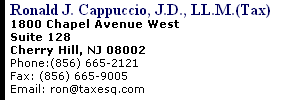
Tax Treatment of the sale of utility
rights of way and easements.
Question: Telephone company
paid owner $13,000 for right of way and
easement through land held for
development. What is the allocation of
basis to such a sale?
Answer: The Cost
Basis of the original land is reduced by sales price
of the easement. If the basis is less than sales price of
easement, the owner has a Schedule D gain on the
difference. If not, there is no gain on sale of
easement.
Legal Explanation:
The taking of an
easement by condemnation across property of a taxpayer that renders
the taxpayer's manufacturing plant inoperable constitutes
an
involuntary conversion. Rev. Rul.60-69,1960-1 C.B. 294. For
example, the sale of a scenic easement
under the threat of condemnation "that restricted the taxpayer's use
of the property" constituted an involuntary conversion even though
the taxpayer retained legal title to the property and could continue
to use the property under the restrictions. In conveying the
easement, the taxpayer gave up a beneficial use of the
property and thereby disposed
of a real property interest. Rev.Rul. 76-69,1976-1
C.B. 219.
On the other hand, the mere fact the taxpayer's
property is sold pursuant to a condemnation
proceeding does not result, in and of itself, in
involuntary conversion treatment. For example, the IRS has denied
involuntary conversion treatment to a developer who consented to the
condemnation and sale of a portion of property as a condition to
receiving zoning approval for development of another parcel of land.
Even though the property was disposed of in a condemnation
proceeding, the IRS determined that it was not an involuntary
conversion. Rev. Rul.69-654,1969-2 C.B. 62.
Property does not
have to be actually taken under
condemnation for there to be an involuntary conversion. The sale by
the property owner under the threat of an
imminent condemnation will also constitute an
involuntary conversion sufficient to defer the recognition of gain.
The mere discussion of the possibility of a condemnation, however,
will not constitute such a threat. Generally, for there to be a
threat or imminence of requisition or condemnation, two elements
must exist. First, the property owner must be informed, either
orally or in writing, by a representative of a governmental agency
that is authorized to acquire the property for public
use, that a
decision has been reached to so acquire the property. It is
sufficient if the information is obtained as the result of a
newspaper article or other news report as long as the property owner
confirms the correctness of the published report from the
appropriate government official. Second, the property owner must
have reasonable grounds to believe that the necessary steps to
condemn the property will be instituted if a voluntary sale is not
arranged. Rev. Rul.63-221,
1963-2 C.B. 332.
Even if the condemning authority does not actually have, either
prior to or at the time of the sale, the authority to
condemn property for public use, a threat or imminence may
exist if the named condemning authority can readily obtain the
necessary authority if a voluntary sale is not arranged. Rev.
Rul.
74-8, 1974-1 C.B. 200.
The General
Rule: If property is compulsorily or
involuntarily converted, the gain is
not recognized as a result of the conversion to
the extent that the converted property is replaced with property
that is similar or related in service or use.

| 







